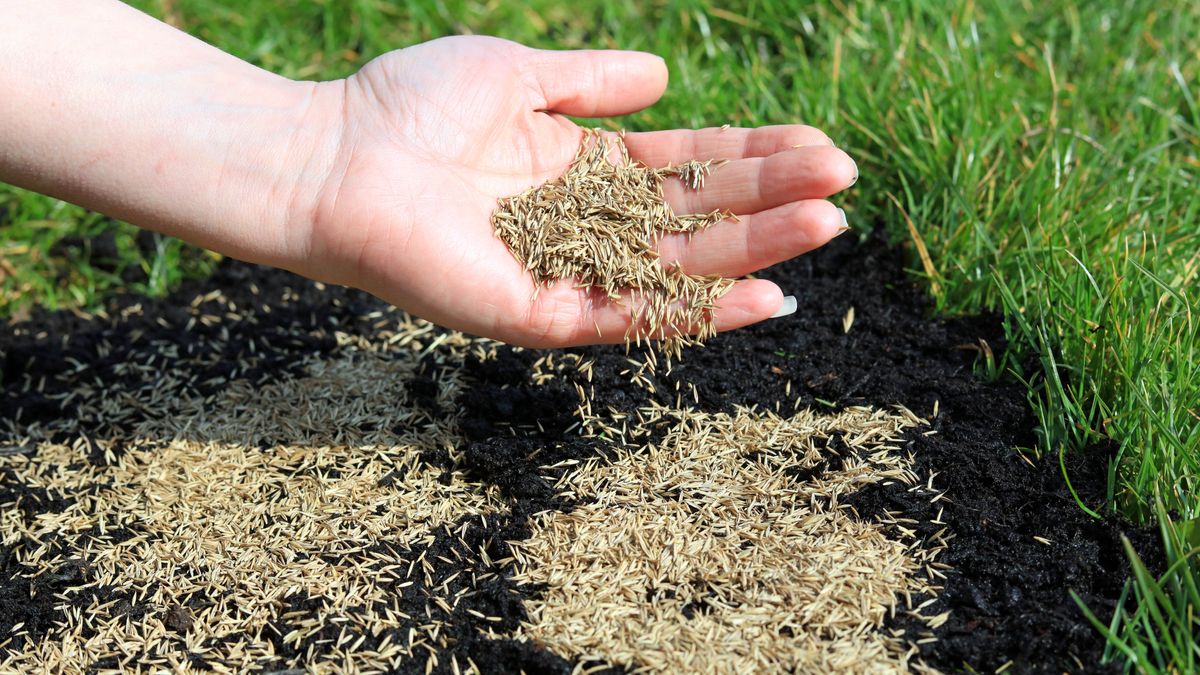Home>Garden Essentials>When To Plant Snapdragon Seeds


Garden Essentials
When To Plant Snapdragon Seeds
Modified: March 15, 2024
Learn when to plant Snapdragon seeds in your garden for beautiful blooms all summer long. Find the best time to start your Snapdragon garden and enjoy vibrant colors in your outdoor space.
(Many of the links in this article redirect to a specific reviewed product. Your purchase of these products through affiliate links helps to generate commission for Storables.com, at no extra cost. Learn more)
Introduction
Welcome to the world of gardening! If you have a green thumb and a passion for nurturing plants, then you’re in for a treat. One of the most charming and popular flowers to grow in your garden is the Snapdragon. With its vibrant colors and unique, spiky blooms, the Snapdragon adds a touch of whimsy and elegance to any space.
In this article, we will delve into the ins and outs of planting Snapdragon seeds. We’ll explore the factors you need to consider before planting, the best time to sow the seeds, and the steps you should take to ensure successful growth. So, put on your gardening gloves and let’s dive in!
Key Takeaways:
- Plant Snapdragons in early spring or fall for best results. Ensure they receive 6-8 hours of sunlight, well-draining soil, and consistent moisture for successful germination and growth.
- Harvest and save Snapdragon seeds for future planting by observing, collecting, cleaning, and storing them. Enjoy the vibrant blooms year after year with proper care and seed propagation.
Read more: How To Sow Snapdragon Seeds
Understanding Snapdragon Seeds
Before you embark on your Snapdragon growing journey, it’s important to familiarize yourself with the nature of Snapdragon seeds. These tiny powerhouses hold the potential for beauty and blooming, but they require certain conditions to thrive.
Snapdragon seeds are small and oval-shaped, usually measuring around 1-2 millimeters in size. They come in a variety of colors, from black and brown to shades of gray and tan. Each seed is equipped with a hard outer coating that protects it during unfavorable conditions. This tough outer shell also makes it important to break the seed’s dormancy, allowing it to germinate and sprout.
Like many other plants, Snapdragons fall into the category of cool-season flowers. This means that they prefer milder temperatures and cooler weather conditions. Understanding this aspect of Snapdragons will help you plan your planting and caring strategies accordingly.
Another important characteristic to note about Snapdragon seeds is their need for consistent moisture during the germination process. This is crucial to trigger the seed’s activation and stimulate growth. Additionally, Snapdragons prefer well-drained soil, as soggy or waterlogged soil can lead to seed rot or fungal diseases.
Now that we have a basic understanding of Snapdragon seeds, let’s explore the factors that you need to consider before planting them.
Factors to Consider Before Planting
Before you dig into the soil and sow your Snapdragon seeds, it’s important to take a few factors into consideration. These factors will help ensure that your Snapdragons have the best chance of thriving in your garden.
1. Sunlight: Snapdragons thrive in full sun to light shade. They require at least 6-8 hours of direct sunlight each day to reach their full potential. Before choosing a spot for your Snapdragons, assess the sunlight exposure in your garden to ensure it meets their needs.
2. Soil Quality: Snapdragons prefer fertile, well-draining soil. Before planting, amend your soil with organic matter, such as compost or aged manure, to improve its texture and nutrient content. This will provide a favorable environment for the seeds to germinate and the plants to grow.
3. Temperature: Snapdragons are cool-season flowers and perform best in mild temperatures. A temperature range of 55-75°F (13-24°C) is ideal for their growth. Be mindful of the weather conditions in your area and plan your planting accordingly.
4. Watering: Adequate watering is crucial during the germination phase for Snapdragon seeds to sprout. Keep the soil consistently moist, but not waterlogged, until the sown seeds germinate. Once the plants have established, water regularly, ensuring the soil remains consistently damp, but not soaked.
5. Spacing: Snapdragons need space to grow and spread out. Ensure proper spacing between the plants to allow for adequate air circulation and prevent overcrowding. This will help reduce the risk of diseases and promote healthier growth.
By considering these factors before planting, you can create an optimal environment for your Snapdragon seeds to flourish. Now let’s explore the best time to sow your seeds for successful germination and growth.
Best Time to Plant Snapdragon Seeds
Timing is crucial when it comes to planting Snapdragon seeds. As cool-season flowers, they have specific preferences when it comes to temperature and growing conditions. Planting them at the right time will optimize their chances of successful germination and growth.
The best time to plant Snapdragon seeds is in early spring when the soil has thawed and the threat of frost has passed. This timing allows the plants to establish strong root systems before the heat of summer arrives.
If you live in a region with mild winters, you may also consider planting Snapdragons in the fall. By doing so, the seeds will undergo a process called cold stratification during the winter months. This natural cold treatment will break the seed’s dormancy and enhance germination rates when spring arrives.
Before sowing the seeds, ensure that the soil temperature has reached a range of 50-70°F (10-21°C). If the soil is too cold, the seeds may struggle to germinate or rot. You can use a soil thermometer to accurately measure the temperature and determine if it’s suitable for planting.
It’s worth noting that Snapdragon seeds can take anywhere from 10 to 21 days to germinate, depending on the conditions and temperature. Therefore, it’s important to be patient and maintain consistent moisture during this period.
In some cases, gardeners decide to start their Snapdragon seeds indoors, in seed trays or pots, before transplanting them to the garden. This can allow for better control of temperature and growing conditions. If you choose this method, start sowing the seeds 8-10 weeks before your estimated last frost date.
By selecting the right time to plant your Snapdragon seeds, you can ensure optimal conditions for successful germination and healthy growth. Now, let’s move on to the preparation steps you should take before sowing the seeds.
Preparation for Planting
Before you sow your Snapdragon seeds, it’s important to prepare the planting area and gather the necessary tools and materials. This preparation will set the stage for successful growth and ensure that your Snapdragons thrive in the garden.
1. Choose the Right Location: Select a sunny or partially shaded spot in your garden that receives at least 6-8 hours of direct sunlight each day. Ensure that the soil is well-draining to prevent waterlogging, which can lead to root rot and other issues.
2. Soil Preparation: Prepare the soil by removing any weeds, rocks, or debris from the planting area. Loosen the soil with a garden fork or tiller to a depth of around 6-8 inches (15-20 cm). If the soil is heavy or clay-like, consider adding organic matter, such as compost or well-rotted manure, to improve its texture and fertility.
3. Test Soil pH: Snapdragons prefer a slightly acidic to neutral soil pH ranging between 6.0-7.0. Use a soil testing kit to determine the pH level of your soil. If the pH is outside the desired range, you can adjust it by adding lime to raise the pH or elemental sulfur to lower it.
4. Amend the Soil: Incorporate organic matter, such as compost or aged manure, into the soil. This will improve its structure, drainage, and nutrient content. Work the organic matter into the top few inches of soil using a garden shovel or fork.
5. Plan Spacing: Determine the spacing requirements for your Snapdragon plants. They typically need about 8-12 inches (20-30 cm) of space between plants. Mark the planting holes or rows accordingly, keeping in mind the final size of the mature plants.
6. Irrigation: Ensure that you have a reliable source of water for your garden. Consider installing a drip irrigation system or set up a sprinkler to provide consistent moisture to your Snapdragon plants. Proper irrigation is essential for their growth and development.
By preparing the soil, testing pH, and planning spacing for your Snapdragons, you’ll create an optimal environment for their growth. With the groundwork laid, it’s now time to sow your Snapdragon seeds and watch them come to life.
Plant snapdragon seeds in early spring, after the last frost has passed. They prefer cool temperatures for germination and growth. Sow seeds directly into well-drained soil and keep them consistently moist.
Read more: How To Save Snapdragon Seeds
Planting Snapdragon Seeds
Now that you have prepared the soil and gathered your tools, it’s time to sow your precious Snapdragon seeds. By following these simple steps, you can ensure proper seed placement and enhance the chances of successful germination and growth.
1. Dig Planting Holes: Use a small garden trowel or your finger to create shallow planting holes in the prepared soil. Each hole should be approximately ¼ to ½ inch (6-12 mm) deep. Space the holes according to the recommended spacing for your specific Snapdragon variety.
2. Sow the Seeds: Place two to three Snapdragon seeds in each planting hole. Gently cover the seeds with soil, ensuring they are evenly covered but not buried too deeply. Lightly press the soil down to compact it slightly.
3. Moisture and Mulch: After sowing the seeds, water them gently to ensure the soil is moist. Avoid overwatering, as excessive moisture can lead to rotting. Consider mulching around the plants with a layer of organic mulch, such as straw or wood chips, to help retain moisture and suppress weed growth.
4. Labeling: It’s helpful to label the planting area with the Snapdragon variety you planted and the date of planting. This will make it easier to keep track of their progress and know when to expect germination.
5. Patience and Care: Now comes the waiting game. Snapdragon seeds typically take 10-21 days to germinate, depending on the conditions. Keep the soil consistently moist during this period and be patient as you wait for the first signs of life.
6. Thin and Transplant: Once the seedlings have sprouted and have a few sets of true leaves, it’s time to thin them out if needed. Leave only the strongest and healthiest seedling in each planting hole. If you started the seeds indoors, transplant the seedlings outdoors once the risk of frost has passed and they are around 4-6 inches (10-15 cm) tall.
By following these planting guidelines, you will give your Snapdragon seeds the best chance at successful germination and growth. Now it’s time to move on to caring for your Snapdragon seedlings.
Caring for Snapdragon Seedlings
Congratulations on successfully germinating your Snapdragon seeds and welcoming the seedlings into the world! Now it’s important to provide the proper care and attention to ensure their healthy growth and development.
1. Watering: Water your Snapdragon seedlings regularly, keeping the soil consistently moist but not waterlogged. Aim to provide about 1 inch (2.5 cm) of water per week, either through rainfall or manual watering. Avoid overhead watering, as wet foliage can promote the development of fungal diseases.
2. Fertilization: Feed your Snapdragon seedlings with a balanced liquid fertilizer every two weeks. Choose a fertilizer with a ratio of N-P-K (nitrogen, phosphorus, potassium) of around 10-10-10 or a similar ratio. This will provide the necessary nutrients for healthy growth and vibrant blooms.
3. Staking Support: As the Snapdragon plants grow taller, they may need support to prevent them from falling over or breaking. Place stakes or small supports around the plants and gently tie them with twine or soft plant ties to keep them upright.
4. Weed Control: Regularly check the planting area for weeds and remove them promptly. Weeds can compete with your Snapdragon seedlings for nutrients and water, hindering their growth. Use mulch or hand-pull weeds to keep the area weed-free.
5. Pruning: Snapping off spent flowers, a process known as deadheading, is important to encourage continuous blooming. Remove the faded blooms regularly to redirect energy into new bud production, resulting in prolonged flowering.
6. Pest and Disease Management: Monitor your Snapdragon seedlings for any signs of pests, such as aphids or snails. If you notice any infestation, treat it with organic pest control methods or consult a local gardening expert for advice. Also, keep an eye out for common diseases like powdery mildew or rust and take appropriate measures to prevent or control them.
By providing adequate water, fertilizer, support, and care, your Snapdragon seedlings will grow into beautiful, healthy plants. Soon you’ll be rewarded with a vibrant display of colorful blooms. However, it’s essential to be aware of common issues and troubleshooting techniques, which we’ll explore in the next section.
Common Issues and Troubleshooting
While Snapdragon plants are generally resilient, they can face certain issues and challenges. Being aware of common problems and their solutions will help you address them promptly and ensure the continued health and vitality of your plants.
1. Disease Control: Snapdragons are susceptible to diseases such as powdery mildew and rust. To prevent these fungal infections, ensure proper spacing between plants for adequate air circulation. If you notice signs of disease, remove infected plant parts and treat with an appropriate fungicide, following the instructions on the label.
2. Pest Infestation: Common pests that can attack Snapdragons include aphids, snails, and slugs. Inspect your plants regularly and manually remove pests when possible. You can also use organic pest control methods such as insecticidal soap or neem oil to manage pest populations.
3. Poor Flowering: If your Snapdragon plants are not blooming as expected, it could be due to various factors. Insufficient sunlight, inadequate fertilization, or overcrowding can all affect flowering. Ensure your plants are receiving enough sunlight, fertilize regularly, and thin out excess seedlings to promote proper airflow and light penetration.
4. Stunted Growth: If your Snapdragon seedlings appear stunted or are not growing well, it may be a sign of nutrient deficiencies, poor soil quality, or improper watering. Test the soil to determine any nutrient deficiencies and adjust fertilizer accordingly. Ensure proper watering by keeping the soil consistently moist but not waterlogged.
5. Wilting: Wilting can occur due to various reasons, including underwatering, overwatering, or root rot. Check the moisture levels in the soil and adjust your watering accordingly. If overwatering or root rot are the issues, adjust your watering schedule and ensure proper drainage by amending the soil if necessary.
6. Environmental Stress: Extreme temperatures or fluctuations can stress Snapdragon plants. Protect them from intense heat or frost by providing shade or using protective covers when needed. Water regularly during hot weather to keep the plants hydrated, and ensure proper insulation during colder months.
By being vigilant and taking proactive measures, you can address common issues and ensure the health and vigor of your Snapdragon plants. Don’t be disheartened if challenges arise; gardening is a learning process, and with time and experience, you’ll become more adept at troubleshooting and maintaining your garden.
Harvesting and Saving Snapdragon Seeds
One of the most rewarding aspects of growing Snapdragons is the ability to save and propagate seeds for future seasons. Harvesting Snapdragon seeds allows you to continue the cycle of growth and enjoy these beautiful flowers year after year. Here’s how you can harvest and save Snapdragon seeds:
1. Observation: Keep an eye on your Snapdragon plants as they start to mature and produce flowers. Look for signs that the flowers have begun to fade and dry out. The petals will wither and fall off, leaving behind seed pods that develop at the base of the flower stem.
2. Seed Pod Formation: Once the flowers have dried, the seed pods will begin to mature and change color. They will turn from green to a light brown or tan shade. This is an indication that the seeds inside are developing and nearing maturity.
3. Harvesting: Once the seed pods have turned a light brown color, they are ready to be harvested. Carefully remove the seed pods from the plant by gently snipping them off with clean garden shears or scissors. Place the harvested seed pods in a clean container or paper bag to collect the seeds.
4. Seed Extraction: To extract the seeds, gently crush or roll the dried seed pods between your fingers. This will help to release the small black or brown seeds. Alternatively, you can open the seed pods by carefully prying them apart with your fingers or a small knife to expose the seeds.
5. Cleaning: After extracting the seeds, it’s important to clean them to remove any remaining plant material or debris. Gently blow on the seeds or use a fine sieve to separate the seeds from the chaff. Take care not to damage or lose the tiny seeds in the process.
6. Drying and Storage: Once the seeds are clean, spread them out in a single layer on a paper towel or tray. Allow them to dry completely in a cool, dry location for about a week. Make sure the seeds are fully dried before storing them in an airtight container or envelope. Label the container with the variety and date of collection.
7. Saving for Planting: Store the sealed container of Snapdragon seeds in a cool, dark, and dry place. They can remain viable for up to three years, although germination rates may decline over time. When you’re ready to plant, simply remove the desired number of seeds from the container and sow them according to the planting instructions.
By harvesting and saving Snapdragon seeds, you can continue to enjoy these delightful flowers in your garden season after season. Remember to select seeds from the healthiest and most vibrant plants to ensure the best quality for future growth.
Read more: How To Start Snapdragon Seeds
Conclusion
Congratulations! You are now equipped with the knowledge and understanding of how to successfully plant, care for, and harvest Snapdragon seeds. By following the guidelines outlined in this article, you can create a garden filled with these captivating and charming flowers.
Remember, Snapdragon seeds require proper preparation, timing, and care to ensure their optimal growth. Consider the factors such as sunlight, soil quality, temperature, and spacing before planting. Provide adequate water, fertilizer, and support to your seedlings as they grow. Address common issues like diseases, pests, and environmental stress promptly to maintain the health of your plants.
The joy of growing Snapdragons extends beyond the blooming season. Harvesting and saving the seeds allows you to continue the cycle of growth and share the beauty of these flowers with others. Take the time to observe the seed pods as they mature, and when ready, collect and clean the seeds for future planting.
Whether you choose to plant Snapdragons in your garden beds, containers, or borders, their vibrant colors, unique structures, and whimsical blooms are sure to bring joy and beauty to your outdoor space.
So, put on your gardening gloves, grab your tools, and get ready to embark on a wonderful journey of planting and growing Snapdragon seeds. Enjoy the process, learn from each experience, and let the beauty of these flowers inspire and brighten your garden for years to come.
Frequently Asked Questions about When To Plant Snapdragon Seeds
Was this page helpful?
At Storables.com, we guarantee accurate and reliable information. Our content, validated by Expert Board Contributors, is crafted following stringent Editorial Policies. We're committed to providing you with well-researched, expert-backed insights for all your informational needs.














0 thoughts on “When To Plant Snapdragon Seeds”